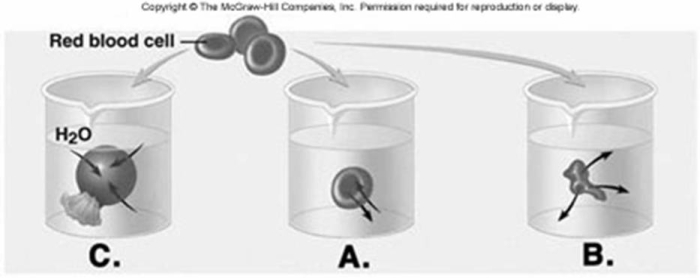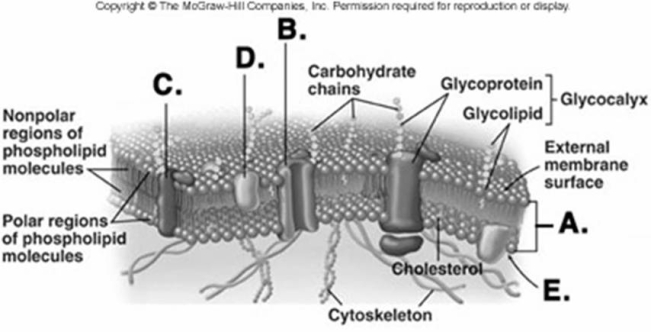A) outside the cell to a region inside the cell.
B) inside the cell to a region outside the cell.
C) of lower concentration to a region of higher concentration.
D) of higher concentration to a region of lower concentration.
E) None of these choices are correct.
Correct Answer

verified
Correct Answer
verified
Multiple Choice
Arrange the following events of exocytosis in the correct sequence: (1) vesicle membrane fuses with plasma membrane (2) secretory vesicles migrate to plasma membrane (3) vesicle contents are expelled from cell (4) secretions accumulate within secretory vesicles
A) 2, 1, 4, 3
B) 1, 4, 2, 3
C) 3, 1, 4, 2
D) 4, 2, 1, 3
E) 1, 2, 3, 4
Correct Answer

verified
Correct Answer
verified
Multiple Choice
Which of the following is NOT true of a transmission electron microscope (TEM) ?
A) The limit of resolution is about 0.1 m.
B) Electrons are passed through the specimen.
C) Gives the clearest three-dimensional images.
D) The specimen must be fixed in plastic.
E) The electron beam is focused with electromagnets.
Correct Answer

verified
Correct Answer
verified
Multiple Choice
What type of membrane proteins have an exposed site on the outer cell surface that can attach to a ligand?
A) marker molecules
B) channel protein
C) receptor proteins
D) enzymes
E) carrier proteins
Correct Answer

verified
Correct Answer
verified
Multiple Choice
The movement of oxygen from the alveoli of the lungs into the bloodstream is an example of
A) diffusion.
B) osmosis.
C) active transport.
D) bulk transport.
E) facilitated diffusion.
Correct Answer

verified
Correct Answer
verified
Multiple Choice
What organelles produce most of the cell's energy?
A) nucleus
B) ribosomes
C) lysosomes
D) mitochondria
E) centrioles
Correct Answer

verified
Correct Answer
verified
Multiple Choice
A cell uses centrioles in the process of
A) cell division.
B) energy generation.
C) protein synthesis.
D) RNA replication.
E) nuclear centering.
Correct Answer

verified
Correct Answer
verified
Multiple Choice
Which of the following sequences is correct?
A) translation protein synthesis transcription
B) transcription translation protein synthesis
C) transcription protein synthesis translation
D) translation transcription protein synthesis
E) protein synthesis translation transcription
Correct Answer

verified
Correct Answer
verified
Multiple Choice
The anticodon sequence GUA pairs with which of the following codons?
A) CAT
B) GUA
C) CTU
D) CAU
E) CTT
Correct Answer

verified
Correct Answer
verified
Multiple Choice
 -Red blood cells (RBCs) have been placed in three different solutions: hypotonic, hypertonic, isotonic. What is solution "B" relative to the RBC?
-Red blood cells (RBCs) have been placed in three different solutions: hypotonic, hypertonic, isotonic. What is solution "B" relative to the RBC?
A) hypotonic solution
B) hypertonic solution
C) isotonic solution
D) hemolyzed
E) crenated
Correct Answer

verified
Correct Answer
verified
Multiple Choice
A runner produced hypotonic sweat while running a marathon in hot weather. After the race, he drank large volumes of water. As a result of the water intake, his body cells will
A) shrink.
B) swell.
C) crenate.
D) shrivel.
E) not change.
Correct Answer

verified
Correct Answer
verified
Multiple Choice
The organelles that are the source of the spindle fibers are the
A) nucleus.
B) ribosomes.
C) lysosomes.
D) mitochondria.
E) centrioles.
Correct Answer

verified
Correct Answer
verified
Multiple Choice
 -What structure does "D" represent on the diagram of the plasma membrane?
-What structure does "D" represent on the diagram of the plasma membrane?
A) membrane channel protein
B) phospholipid bilayer
C) internal membrane surface
D) peripheral protein
E) integral protein
Correct Answer

verified
Correct Answer
verified
Multiple Choice
Arrange the following in correct sequence: (1) protein moves through ER and then carried in vesicles to Golgi apparatus (2) vesicle pinches off from the Golgi apparatus and carries product to plasma membrane (3) Golgi apparatus modifies protein and then packages them into vesicles (4) protein made by ribosomes on rough ER
A) 1, 2, 3, 4
B) 4, 1, 3, 2
C) 2, 3, 1, 4
D) 3, 2, 4, 1
E) 4, 3, 2, 1
Correct Answer

verified
Correct Answer
verified
Multiple Choice
Portions of pre-mRNA that do NOT code for parts of a protein are called
A) introns.
B) start codons.
C) exons.
D) stop codons.
E) All of these except exons do not code for parts of a protein.
Correct Answer

verified
Correct Answer
verified
Multiple Choice
 -Red blood cells (RBCs) have been placed in three different solutions: hypotonic, hypertonic, isotonic. What is solution "A" relative to the RBC?
-Red blood cells (RBCs) have been placed in three different solutions: hypotonic, hypertonic, isotonic. What is solution "A" relative to the RBC?
A) hypotonic solution
B) hypertonic solution
C) isotonic solution
D) hemolyzed
E) crenated
Correct Answer

verified
Correct Answer
verified
Multiple Choice
Determine the sequence of the following events in a cell after exposure of the cell to a chemical signal. (1) increased synthesis of a protein (2) the chemical signal combined with a cytoplasmic receptor (3) an increase in the nuclear concentration of the chemical (4) an increase in mRNA synthesis (5) genes are activated
A) 2, 1, 3, 5, 4
B) 2, 4, 5, 3, 2
C) 2, 3, 5, 4, 1
D) 2, 3, 4, 5, 1
E) 1, 2, 3, 4, 5
Correct Answer

verified
Correct Answer
verified
Multiple Choice
Experimental manipulation to increase the energy output of the cell might include
A) rupturing the lysosomes in the cell.
B) increasing the number of mitochondria.
C) decreasing nuclear size.
D) removing some of the ribosomes.
E) increasing protein synthesis.
Correct Answer

verified
Correct Answer
verified
Multiple Choice
In order to study in detail the anatomy of internal cell parts, it would be best to use
A) x-rays.
B) flashlights.
C) a transmission electron microscope (TEM) .
D) tissue cultures.
E) a scanning electron microscope (SEM) .
Correct Answer

verified
Correct Answer
verified
Multiple Choice
The predominant lipid in the cell membrane is a
A) phospholipid.
B) glycolipid.
C) cholesterol.
D) prostaglandin.
E) triglyceride.
Correct Answer

verified
Correct Answer
verified
Showing 161 - 180 of 211
Related Exams